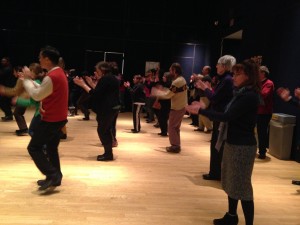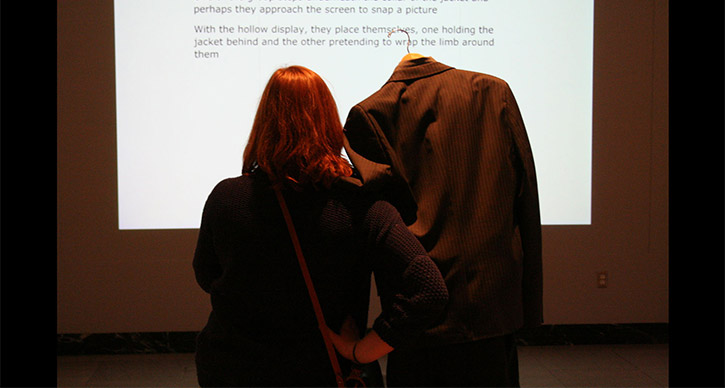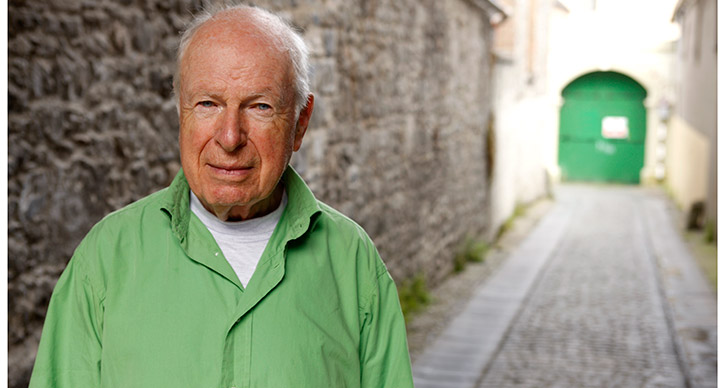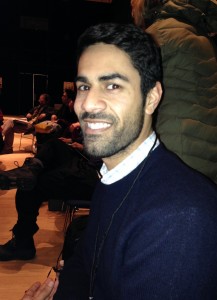UMS Night School: Bodies in Motion – Session 3 Recap
Editor’s note: This post is a part of a series of by U-M student Sarah Squillante, who’s covering our free UMS Night School: Bodies in Motion series. Learn along side with them.

UMS Night School attendees danced to a new beat this week – literally. Midway through the session, attendees were asked to get up on their feet, learn a basic Capoeira step, and then free-style in a large circle to funk music. The movement exercise, led by U-M Dance MFA Candidate Marcus Whiten, gave attendees a kinesthetic taste of a distinct style – a mix of hip hop, martial arts, and acrobatics – that Compagnie Käfig will bring to Ann Arbor this weekend, February 14 and 15.
This week also marked the beginning of a new format in which attendees have the opportunity to discuss a recent dance performance. This week’s discussion centered around “Moving Pictures,” a concert featuring 4 works performed by the U-M department of Dance. In a short panel discussion, three dancers spoke first of the larger ideas that they were asked to conceptualize during the beginning stages of the pieces, then progressed to more specific elements of the performance, like costuming and live music. The dancers expressed delight in the challenges that the pieces provided and in the connections that they were able to make with the audience.
The attendees comprised a diverse a group as usual, ranging from experienced dancers to those who had never seen a performance before. The class has grown significantly since the first week. Some have become Night School “regulars,” while others ventured out into the cold for the first time.
In the left photo, newcomer Razi Jafri said he came because he “didn’t really know anything about dance – artistically or technically,” so he figured it’d be a good introduction.
On the right, Lucie Cohen and Deb Taylor came to Night School thinking they’d be seeing a dance performance, but were pleasantly surprised by the discussion format. “I really enjoyed getting involved when we started moving. The proximity of our bodies made me feel like I knew people on a personal level,” Lucia said.
Leslie Woldenberg, a dance lover and frequent UMS patron, drove all the way from Toledo with a friend to experience Night School for the first time.
The session finished with a short talk from Reighan Gillam, Postdoctoral research fellow in the U-M Department of Afroamerican and African Studies, who spoke about the origins of hip-hop music and dance in Brazil. Gillam emphasized the fact that rappers come from the periphery of Brazil and that, much like hip hop in the United States, the content typically revolves around the violence and system inequality characteristic of marginalized groups.
The details – and the questions they inspired – were intended to help attendees frame their viewing of Compagnie Käfig. Night School host Clare Croft suggested that attendees use information from the lecture to consider how the atmosphere in Brazil may impact the movement they see on stage.
The fourth session of Night School will include an exploration of how actors think about movement, with a preparation for Théâtre des Bouffes du Nord’s The Suit, and also a discussion of Compagnie Käfig’s Correria Agwa. Special guests will include: Naomi Andre, U-M Associate Professor of Women’s Studies, Rob Najarian, U-M Assistant Professor of Theatre, and Michael Kondziolka, UMS Director of Programming. It will be held at the U-M Alumni Center at 200 Fletcher Street at 7 PM.
Session 3 Resources & Readings
- UMS Learning Guide on Compagnie Käfig
- Performance prep reading on Capoeira – “Headspin” by Barbara Browning
- Bodies in Motion Session 3 – Key Themes, Players, and Definitions [Word Document assembled by Marcus White, MFA Candidate – Dance, University of Michigan]
- Session 4 Prep Reading: Excerpt from Peter Brook’s The Open Door
Interested in even more dance engagement? Pick up an adventure card to learn all about the dance activities we’re offering this year and for a chance to win a backstage meet and greet.
For a complete list of 2013-2014 dance performances, visit ums.org. Share questions, comments, or suggestions in the comments below.
Putting On “The Suit”
Editor’s note: Student volunteers at UMS often get the chance to take a deep dive into a performance or art form. In this essay, UMS Marketing intern Clare Brennan reflects on her experiences with “The Suit” directed by the legendary stage and film director Peter Brook. The performance will be at Ann Arbor’s Power Center on February 19-22, 2014.

Photo: Clare Brennan and the UMS Student Committee take the suit around town as part of U-M Museum of Art’s “Love Art More” project. Photo by UMS Student Committee.
It’s not hard for me to remember one of the first books that really moved me. I was sitting in my living room, home alone on a bright August afternoon, finishing up some reading I’d been assigned for my last year of English in high school. I read the final paragraph, closed the back cover, and sat quietly for a while. I might’ve teared up a bit, if I’m being honest. The book was Alan Paton’s Cry, The Beloved Country, and it was then that I became infatuated with the stories and storytellers from South Africa.
As it turns out, my love for the French language and culture was growing right alongside this, as well as an absolute obsession with all things regarding Anglo-Saxon theater. Imagine, then, my elation when an opportunity to dive head first into The Suit fell into my lap. My nerdy heart fluttered. I accepted as nonchalantly as I could.
Apparently, my fixation with The Suit is not uncommon. Legendary theatrical director Peter Brook loved this story so much that, after directing the story once in French in 1999, he chose to return to it, this time in English. I had the chance to sit down with Michael Kondziolka, the Director of Programming here at UMS. He saw the debut of this production of The Suit last year in New York, and knew that Ann Arbor had to have the chance to see it. “It’s so painterly. A supreme colorist can use shadow and light and color and understands exactly how to use these different media to create a masterpiece. That’s what Peter Brook is doing. He knows how to use actors and written text and music and light and staging and movement and the audience, and how to craft all of that into something that is really powerful, really masterful.”
Of course, any discussion of South Africa must mention the recent passing of Nelson Mandela. The Suit is set on the cusp of Mandela’s most prominent years, and this energy of anticipation of what’s to come silently fills the stage. It provides an opportunity to see a South Africa without Mandela and his work, and as the world reflects on his incredible dedication to his country, taking a moment to step back and hear from those who came before him feels even more powerful.
With that context, The Suit might seem like a eulogy. Far from it. In talking with Michael, I got the chance to hear about what makes a Peter Brook piece tick. At the heart of each of his works is a dedication to simplicity. “This piece has a real lightness to it. And the lightness comes from the performance.” Over almost half- century of work, Brook has pared down his stages, from the intricate scenery of his staging of the Bard for the Royal Shakespeare Company to the openness of The Suit’s space. “It creates a sense of the fun of the performance. So you’ve got this really interesting visual experience. Your imagination is unlocked as an audience member, and that’s really entertaining and satisfying.” Brook trusts his audience, an honor not frequently given, and we’re free to reap the benefits.
While we covered many topics, my chat with Michael really focused on the music embedded in the show. From Schubert on the accordion to a poignantly placed introduction of Bach’s St. Matthew’s Passion (what Michael reverently referred to as “The Sistine Chapel of classical music”), it is evident that Brook knows exactly how to carefully weave music into his work. “Peter Brook is not only a master theater maker but he clearly is a student of culture, and the way in which he understands the meaning of these specific pieces of music and uses them to get his theatrical idea across.”
Studying up for The Suit has been a joy. Peter Brook knows how to tell a story, and his ability to transcend the barriers of the stage and approach each member of the audience with this incredible story of love and loss has no comparison. I’m so looking forward to seeing this show and finding what discoveries I still have left to make. The stage has a magical quality, and, in The Suit, it’s clear that Peter Brook knows it. “It’s pure poetry,” as Michael eloquently sums up. From what I can tell, I think he’s on to something .
Interested in learning more? Check out a brief infographic history of Peter Brook’s career or watch a storybook introduction to the performance.
Sources:
http://www.bouffesdunord.com/en/about-us/peter-brook
http://frenchculture.org/visual-and-performing-arts/events/us-premiere-suit-directed-peter-brook
A [brief] UMS History Presentation: Peter Brook

Photo: Peter Brook. Photo by Colm Hogan.
Director Peter Brook’s contributions to theater have spanned stage, film, and literary worlds. He directs The suit, performed by Théâtre des Bouffes du Nord at the Power Center in Ann Arbor February 19-22, 2014.
His legendary career has spanned decades and the world. Explore the timeline in this infographic:




